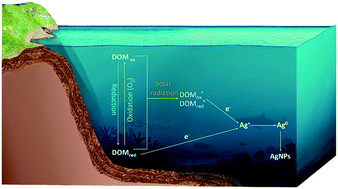Reduction of silver ions to form silver nanoparticles by redox-active organic molecules: coupled impact of the redox state and environmental factors†
Abstract
The release of silver ions (Ag+) is an important process in determining the environmental fate and toxic effects of silver nanoparticles (AgNPs), but the released Ag+ can be reduced to form new AgNPs in environments. Here the reduction of Ag+ by redox-active organic molecules to form AgNPs under different lighting and oxygen conditions was investigated using anthraquinonoe-2,6-disulphonate (AQDS) and nicotinamide adenine dinucleotide (NAD+) as representatives. In anaerobic environments, oxidized AQDS (AQDSox) and NAD+ failed to reduce Ag+ to form AgNPs, whereas reduced AQDS (AQDSred) and NAD+ (NADH) produced a concentration-dependent AgNP production pattern, underlining a key role of the redox state in Ag+ reduction by organics. The presence of O2 diminished the reducing capacity of NADH and AQDSred, probably due to their oxidation by O2. However, under UV light, the AgNP formation rate was dramatically enhanced in AQDS, independent of O2. Our results revealed that the Ag+ photoreduction was mainly attributed to the photoexcited AQDS, not the radical intermediates. For the complex organic humic acid (HA), and consistent with the phenomena in AQDS, the reduced HA (HAred) reduced Ag+ at a much faster rate than the native HA (HAox) in anaerobic and dark environments, and the amounts of AgNPs produced by HAred decreased in oxic environments. UV illumination enabled significant Ag+ reduction in both HAox and HAred, and O2 promoted the AgNP formation. Our study systematically revealed different Ag+-reduction pathways to form AgNPs, with an organic's redox state and environmental factors having a combined effect.



 Please wait while we load your content...
Please wait while we load your content...